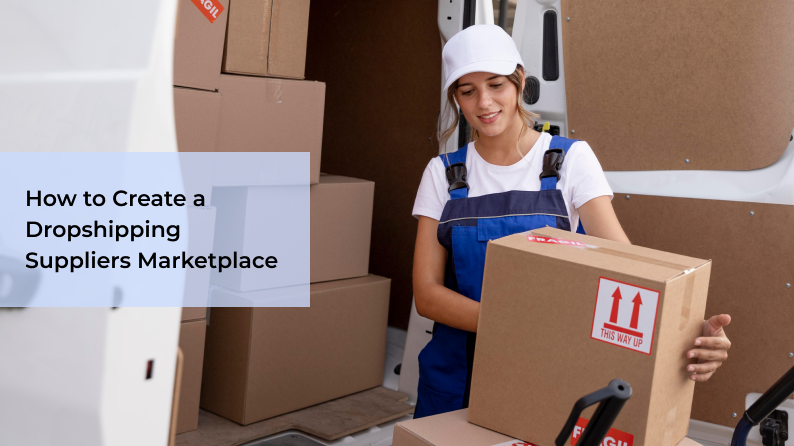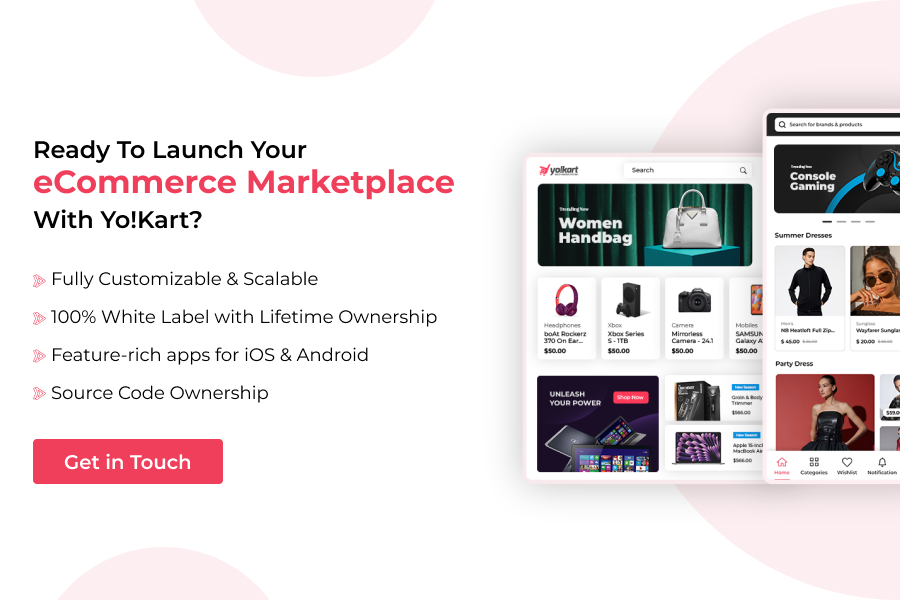Published On 23rd June, 2025
Dropshipping is reshaping the global eCommerce landscape, with the market projected to surpass $1,253.79 billion by 2030 at a CAGR of 22.0% from 2025 to 2030. Its low upfront investment and scalable model have made it especially popular among new entrepreneurs. However, one of the biggest barriers to success in dropshipping remains the difficulty of finding reliable suppliers.
To address this issue, more businesses are turning to a new and lucrative model: creating online marketplaces specifically for dropshipping suppliers. These platforms connect retailers with vetted suppliers, streamlining product discovery, order management, and fulfillment.
In this guide, we’ll explore how to create a marketplace for dropshipping suppliers that serves as a trusted B2B hub for online commerce.
Table of Contents
- What is a Dropshipping Supplier Marketplace?
- Why Start a Dropshipping Supplier Marketplace?
- Key Features of a Dropshipping Supplier Marketplace
- Possible Revenue Models of Dropshipping Supplier Marketplace
- Steps to Build a Dropshipping Supplier Marketplace
- Best Platform to Launch a Dropshipping Supplier Marketplace
- Key Challenges in Building a Dropshipping Supplier Marketplace – and How to Solve Them
- How to Effectively Market Your Dropshipping Supplier Marketplace in 2025?
- Final Thoughts
- FAQs
What is a Dropshipping Supplier Marketplace?
A dropshipping supplier marketplace is a specialized B2B eCommerce marketplace that acts as a digital bridge between suppliers and online retailers. In this ecosystem, suppliers can register themselves on the platform, list their products, and manage orders, while retailers can browse through product catalogs, evaluate supplier credibility, and seamlessly import products into their own online stores for resale.
These marketplaces offer an infrastructure that simplifies complex supply chain processes such as inventory synchronization, order tracking, and payments, allowing small and mid-sized retailers to expand their product range without investing in warehousing or logistics.
Unlike a standard dropshipping store, where a single business sells products directly to end-consumers by sourcing them from third-party suppliers, a dropshipping supplier marketplace connects multiple suppliers and retailers, enabling them to work together. The platform owner generates revenue through commissions, subscription models, or premium features, essentially functioning like a wholesale hub built for digital operations.
Why Start a Dropshipping Supplier Marketplace?
The demand for dropshipping is booming worldwide, driven by a growing number of entrepreneurs who are eager to enter the eCommerce space without the risks associated with inventory and logistics. Yet, one of the most persistent challenges in this model is finding and maintaining relationships with reliable suppliers. This issue creates a perfect opening for a new kind of business: A Dropshipping Supplier Marketplace.
By launching a centralized platform where vetted suppliers can showcase their products and where retailers can easily search, compare, and connect with them, you can address a major gap in the supply chain. Such a marketplace eliminates the need for manual outreach, complicated contracts, or expensive directories that offer little in the way of transaction management. Instead, it streamlines the entire process, empowering both suppliers and resellers.
Here’s why now is the ideal time to launch a dropshipping supplier marketplace:
- High Market Potential: Dropshipping is expected to grow to over $500 billion by 2027. Entrepreneurs and retailers around the world are looking for trusted platforms to source products.
- Low Inventory Risk: As a marketplace owner, you act as a facilitator rather than a seller. This means no warehousing costs, no logistics management, and lower operational overhead.
- Recurring Revenue Streams: You can monetize the platform through multiple avenues such as transaction-based commissions, subscription plans, premium listings, advertising, and more.
- Mutual Benefits for All Parties: Suppliers get increased visibility and access to new markets without investing in additional infrastructure, while retailers get a convenient and reliable channel to source curated, ready-to-ship products.
- Opportunity for Niche Dominance: While general dropshipping marketplaces are widely available, many niche markets remain untapped, such as eco-friendly products, handmade goods, or region-specific items, where a new marketplace can quickly establish authority and attract a loyal user base.
Key Features of a Dropshipping Supplier Marketplace
To ensure a seamless experience for both suppliers and retailers, a dropshipping supplier marketplace must be equipped with the following core features, each serving a critical function in facilitating trust, efficiency, and scalability:
- Supplier Registration & Verification: This allows new suppliers to sign up, provide essential business details, and undergo a vetting process. Verification ensures credibility, reduces the risk of fraud, and builds trust within the ecosystem.
- Product Listing & Bulk Uploading: Suppliers should be able to list products individually or in bulk through CSV upload or API integrations. Rich product details (images, descriptions, prices, and variants) are crucial for helping retailers make informed decisions.
- Real-Time Inventory Sync: This feature ensures that the inventory levels displayed on the marketplace are always up to date. Automated inventory synchronization prevents overselling and understocking by reflecting real-time stock changes made by suppliers.
- Order Routing & Fulfillment Tracking: When a retailer places an order, the system should automatically notify the corresponding supplier for fulfillment. Built-in order management tools, including shipping status updates and real-time product tracking, are essential for transparent delivery workflows.
- Messaging System Between Retailers and Suppliers: Communication is key in B2B transactions. A secure messaging system enables both parties to discuss product specifications, resolve queries, and negotiate deals directly through the platform.
- Commission and Payment Handling System: The dropshipping suppliers marketplace must support flexible commission models and automate payment distribution to suppliers after deducting platform fees. It should include multiple payment gateways and currency options for global scalability.
- Ratings & Reviews: After each transaction, retailers should be able to rate and review suppliers based on factors like product quality, communication, and fulfillment speed. This social proof enhances accountability and aids decision-making for other users.
- Admin Dashboard with Full Control and Analytics: The admin panel should allow marketplace owners to manage user roles, modify listings, set commission structures, view revenue reports, and monitor platform health. Real-time analytics enable data-driven growth strategies.
Launch a Powerful Dropshipping Suppliers Marketplace with Advanced Features
Possible Revenue Models of Dropshipping Supplier Marketplace
A well-planned monetization strategy is essential for the long-term success and sustainability of your dropshipping supplier marketplace. Since you’re operating as a facilitator rather than a direct seller, your revenue will come from the ecosystem you build between suppliers and retailers. Below are some proven and scalable ways to generate consistent income from your platform:
- Transaction Fees: This is the most common monetization model. You can charge a commission on each successful transaction made through the platform.
- Subscription Plans for Suppliers: Offer tiered monthly or annual subscription packages with varying levels of access.
- Featured Listings and Sponsored Ads: Allow suppliers to promote specific products or their entire store through paid advertising placements on the homepage, category pages, or search results.
- RFQ (Request for Quotation) Services: You can charge suppliers to access the qualified leads or offer RFQ response capabilities as part of a premium package.
- Value-Added Services: Go beyond the core marketplace functionality and offer extra services such as branded packaging, dropshipping automation tools, custom storefronts, or third-party fulfillment services.
- Affiliate Commission Program: Introduce a referral program where external users, influencers, or even current suppliers can earn commissions by bringing new users to the platform.
- Platform Access Fees: Charge access fees for advanced features such as bulk import/export, detailed market analytics, or supplier performance insights.
Steps to Build a Dropshipping Supplier Marketplace
Building a dropshipping supplier marketplace involves strategic planning, a solid understanding of your target audience, and the implementation of the right technologies. Below are the expanded steps that will guide you in developing a marketplace that is scalable, trustworthy, and competitive.
1. Market Research and Niche Selection
Start by identifying underserved niches or emerging trends within the dropshipping landscape. Analyze existing dropshipping suppliers marketplaces, conduct competitor audits, and assess gaps that can be filled with a more specialized or value-driven offering. Consider industries like eco-friendly goods, pet supplies, health and wellness, or region-specific handmade products. Market research should include buyer personas, supplier pain points, and revenue models within your chosen domain.
2. Define Your Business Model & Monetization Strategy
Begin by clearly defining the operational framework of your dropshipping supplier marketplace. Identify your target users, such as product suppliers and online retailers, and determine how they will interact within the platform. Outline essential workflows like product listing, supplier onboarding, and order processing to ensure seamless coordination and functionality as your marketplace scales and attracts more users.
3. Choose the Right Tech Platform
You can either custom-develop the platform or use a pre-built solution to create a marketplace for dropshipping suppliers, depending on your budget, timeline, and scalability needs. Although custom development offers full control, but also requires significant investment and time. On the contrary, readymade solutions like Yo!Kart offers quick deployment, robust features, self-hosting, and flexibility to scale your operations as you grow.
Additionally, look for platforms that support multi-vendor functionality, real-time inventory sync, automated payment processing, and customizable design. Ensure the solution is mobile-responsive and SEO-optimized.
4. Design User-Friendly UI/UX
A seamless and intuitive interface encourages engagement and conversion. Your platform’s design should:
- Enable easy navigation through product categories and supplier profiles
- Offer advanced filters and search options
- Provide clear CTAs (Call-to-Actions)
- Be mobile-first to cater to global audiences
- Include trust signals like badges, supplier ratings, and transaction security highlights
Consider integrating modern UI trends and conducting usability testing to refine user flows.
Develop a User-Friendly, Intuitive Marketplace for Dropshipping Suppliers
5. Enable Seamless Supplier Onboarding
Create a frictionless onboarding process with step-by-step instructions, FAQs, and live support. Include features like:
- Easy registration and profile creation
- Business verification and documentation uploads
- Automated approval workflows
- Tutorials for product listing
Streamlining onboarding increases supplier retention and trust in the platform.
6. Integrate Payment Gateways and Logistics APIs
To facilitate secure and global transactions, integrate trusted payment gateways (PayPal, Stripe, Razorpay, etc.) and support multiple currencies. Consider split payment systems that automatically distribute funds between suppliers and platform owners.
Logistics APIs can enable features like real-time shipping rate calculations, label generation, tracking updates, and automatic order status updates.
7. Test, Launch, and Market Your Platform
Before going live, conduct thorough testing across devices, browsers, and user roles. Use test data to validate workflows, transactions, and communication tools. Launch in beta mode with a selected group of suppliers and retailers to gather feedback.
Post-launch, invest in performance marketing, SEO, and influencer outreach. Host webinars, attend eCommerce expos, and engage in partnerships to grow your network.
This step-by-step approach will help you build a solid foundation for a successful, profitable, and future-proof dropshipping supplier marketplace.
Best Platform to Launch a Dropshipping Supplier Marketplace
Selecting the right technology foundation is crucial to the long-term success of your dropshipping supplier marketplace. The platform you choose must offer scalability, B2B functionality, ease of use, and customization capabilities to suit the diverse needs of both suppliers and retailers. Hence, out of the various options available in the market, Yo!Kart stands to be the best eCommerce marketplace software to create a marketplace for dropshipping suppliers.
Yo!Kart is a self-hosted, fully customizable eCommerce marketplace software built to support complex, large-scale marketplace operations. Designed with flexibility and control in mind, it enables entrepreneurs to launch a feature-rich dropshipping supplier marketplace without being tied to recurring subscription fees. Its one-time license model, combined with complete ownership of the platform, makes it a cost-effective, long-term solution.
Why Choose Yo!Kart for Your Dropshipping Suppliers Marketplace:
- Built-in Multi-Vendor Architecture – Seamlessly manage multiple suppliers, each with their own dashboard and product catalogs.
- Advanced Supplier Management – Control product approvals, commissions, and shipping options at a granular level.
- Multilingual & Multicurrency Support – Easily scale to international markets and serve global buyers and sellers.
- Customizability – Modify and extend the platform’s features to meet your unique business model and branding needs.
- B2B-Ready Features – Includes quote requests, bulk pricing, and flexible product visibility to cater to wholesale buyers.
- Robust Admin Controls – Gain full control over user management, transactions, content, and commission settings.
- Secure & Scalable Infrastructure – Built to handle growth, with strong security standards and performance optimization.
- Pre-Integrated APIs & Payment Gateways – Simplifies setup and operations with essential integrations out of the box.
- SEO & Marketing Tools – Helps improve visibility, drive traffic, and grow your brand organically.
- Mobile-Optimized Design – Ensures a smooth user experience across devices, increasing engagement and conversions.
In addition to these core strengths, Yo!Kart offers dedicated 1 year of free technical support, white-label capabilities, mobile-ready design, and native mobile apps for Android and iSO, making it ideal for modern, supplier-driven marketplaces. Whether you’re targeting domestic or international sellers, Yo!Kart provides the tools, flexibility, and reliability needed to thrive in the competitive dropshipping landscape.
Secure a Personalized Demo Session to See Yo!Kart in Action
Key Challenges in Building a Dropshipping Supplier Marketplace – and How to Solve Them
Launching a successful dropshipping suppliers marketplace comes with its own set of challenges. From ensuring supplier reliability to maintaining a seamless user experience, various operational, technical, and strategic hurdles must be addressed to ensure long-term platform viability. Understanding these challenges in advance will help you plan proactively, avoid common pitfalls, and create a resilient business model.
Here are some of the most common challenges faced by businesses while building a marketplace for dropshipping suppliers and their solutions:
- Verifying Supplier Authenticity: One of the biggest concerns in the dropshipping business is ensuring that the suppliers on your platform are genuine and deliver high-quality products on time. To mitigate this, implement a multi-stage supplier verification process that includes identity validation, business license checks, and sample product evaluations. Additionally, you can introduce a rating and review system to enhance trust.
- Maintaining Real-Time Inventory Accuracy: Inaccurate inventory data can lead to overselling or order cancellations, which damages your platform’s reputation. Therefore, ensure you have integrations or APIs that sync inventory levels between supplier systems and your marketplace in real time. Encourage suppliers to update their stock regularly or automate the process where possible.
- Handling Disputes, Returns, and Refunds: Disputes between retailers and suppliers over delayed shipments, damaged goods, or incorrect orders are common. Establish clear terms of service, refund policies, and a dispute resolution framework. Moreover, you can consider integrating a helpdesk or support ticketing system that can efficiently handle conflict mediation.
- Building Trust Between Buyers and Suppliers: New retailers may hesitate to work with unknown suppliers, and vice versa. Thus, fostering transparency by providing supplier ratings, verified badges, customer feedback, and detailed profiles is essential. Educational resources, case studies, and platform guarantees can further help to build confidence.
- Platform Fee Optimization: Striking a balance between profitability and affordability is key. If your commission rates or subscription fees are too high, you may drive away potential suppliers. On the other hand, low charges can make your business unsustainable. Hence, offer flexible pricing tiers or allow suppliers to choose plans based on their sales volume and product range that caters to varied customer needs while optimizing your revenue strategies and keeping the profit in check.
- User Experience and Technical Glitches: A slow, buggy, or complex interface can turn users away. Regularly test for bugs, ensure mobile optimization, and prioritize speed and navigation clarity. Additionally, offer tutorials and onboarding assistance for new users.
- Legal and Regulatory Compliance: Depending on your region and the countries where suppliers and retailers operate, you’ll need to comply with tax regulations, eCommerce laws, data protection standards (such as GDPR), and international shipping policies. Consult with legal advisors to ensure your marketplace operations are fully compliant.
How to Effectively Market Your Dropshipping Supplier Marketplace in 2025?
Marketing plays a critical role in the success of your dropshipping supplier marketplace. Even the most feature-rich marketplace will fail to thrive without visibility among the right audience, both suppliers and retailers. As a marketplace owner, you must adopt a multi-channel strategy that not only attracts new users but also nurtures long-term engagement and platform loyalty.
Here are the most effective marketing strategies to grow your dropshipping supplier marketplace in 2025 and beyond:
- Search Engine Optimization (SEO) & Content Marketing: Develop a strong SEO strategy with optimized landing pages for each category, supplier profile, and niche segment. Create informative blog posts, how-to guides for suppliers and dropshippers, and downloadable resources like whitepapers or trend reports. This positions your marketplace as an authoritative voice in the industry and helps drive organic traffic.
- Influencer and Affiliate Marketing: Collaborate with influencers in the eCommerce, wholesaling, or niche product spaces who can promote your platform to their followers. Launch an affiliate program to incentivize content creators, bloggers, and B2B partners to refer new users to your marketplace.
- Google Ads, Meta Ads, and LinkedIn Campaigns: Paid search and display campaigns can help you reach targeted buyers and suppliers quickly. Google Ads are great for capturing high-intent traffic, while LinkedIn and Meta platforms can be used for audience segmentation and retargeting professionals in specific industries.
- Trade Partnerships and Supplier Networks: Partner with trade show organizers, wholesale directories, or business chambers to gain exposure to verified suppliers. You can also co-host webinars, virtual expos, or educational workshops that attract both sellers and buyers.
- Email Marketing & Drip Campaigns: Build segmented email lists for both potential suppliers and retailers. Share onboarding tips, platform updates, supplier success stories, and promotional offers. Use drip campaigns to guide new users through key actions like listing a product or making their first transaction.
- Social Proof and Case Studies: Showcase testimonials, video reviews, and detailed case studies of successful suppliers and retailers on your platform. These stories build trust and provide real-world examples of how your marketplace adds value.
- Referral Programs and Loyalty Rewards: Encourage users to invite others by offering incentives like commission discounts, premium listings, or cash rewards. Gamified reward systems help maintain user interest and drive ongoing growth.
Leverage Powerful Marketplace Software with Built-In Marketing Tools
Final Thoughts
The dropshipping boom presents a golden opportunity to create a B2B marketplace tailored to the supplier and retailer needs. With the right strategy, technology, and marketing, you can create a marketplace for dropshipping suppliers that thrives in the industry, generates recurring revenue, and adds real value to the eCommerce supply chain.
Finally, if you’re ready to take the first step, explore marketplace solutions like Yo!Kart that are designed to support your vision.
FAQs
1. How much does it cost to build a dropshipping supplier marketplace?
Ans. The cost of building a dropshipping supplier marketplace varies significantly based on the development approach you choose. If you opt for custom development, expenses can range from $5,000 to over $50,000, depending on features, complexity, and developer rates. In contrast, using a pre-built solution like Yo!Kart can reduce this cost by up to 5 times, offering all essential features out of the box with a one-time license fee, making it a far more affordable and time-efficient alternative.
2. Can I launch a B2B-only marketplace for dropshipping suppliers?
Ans. Yes, you can absolutely launch a B2B-only marketplace for dropshipping suppliers. In fact, B2B marketplaces are well-suited for dropshipping models that involve bulk ordering, negotiated pricing, and supplier-retailer relationships. Platforms like Yo!Kart comes equipped with B2B-specific features, making it easy to build a dropshipping suppliers marketplace that caters exclusively to business buyers and suppliers.
3. How do I ensure the reliability of suppliers on my dropshipping suppliers marketplace?
Ans. To ensure supplier reliability, you need a structured approach to screening, monitoring, and managing supplier performance. Here’s how you can do it effectively:
- Thorough Onboarding & Verification
- Set Clear Standards
- Real-Time Performance Tracking
- Ratings & Reviews
- Regular Quality Audits
By combining these practices with strong platform controls, you can build a trustworthy and high-performing supplier network on your marketplace.
4. Which platform is best for launching such a marketplace?
Ans. A feature-rich, scalable platform like Yo!Kart is ideal for launching a dropshipping supplier marketplace. This is because it offers multi-vendor support, B2B functionality, full customization, and a one-time license cost, making it both cost-effective and future-ready.




